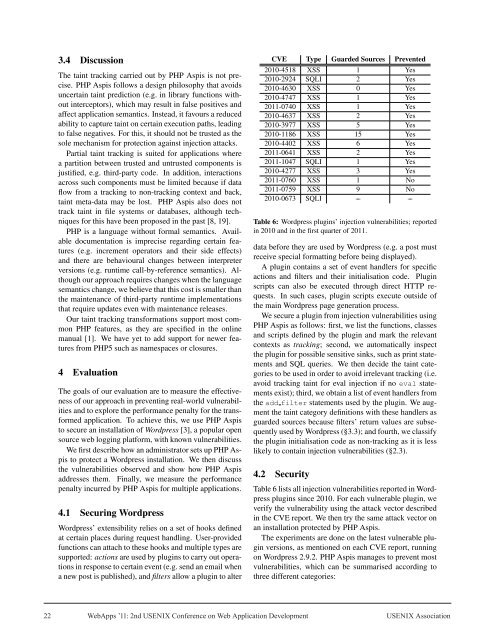2nd USENIX Conference on Web Application Development ...
2nd USENIX Conference on Web Application Development ...
2nd USENIX Conference on Web Application Development ...
Create successful ePaper yourself
Turn your PDF publications into a flip-book with our unique Google optimized e-Paper software.
3.4 Discussi<strong>on</strong><br />
The taint tracking carried out by PHP Aspis is not precise.<br />
PHP Aspis follows a design philosophy that avoids<br />
uncertain taint predicti<strong>on</strong> (e.g. in library functi<strong>on</strong>s without<br />
interceptors), which may result in false positives and<br />
affect applicati<strong>on</strong> semantics. Instead, it favours a reduced<br />
ability to capture taint <strong>on</strong> certain executi<strong>on</strong> paths, leading<br />
to false negatives. For this, it should not be trusted as the<br />
sole mechanism for protecti<strong>on</strong> against injecti<strong>on</strong> attacks.<br />
Partial taint tracking is suited for applicati<strong>on</strong>s where<br />
a partiti<strong>on</strong> between trusted and untrusted comp<strong>on</strong>ents is<br />
justified, e.g. third-party code. In additi<strong>on</strong>, interacti<strong>on</strong>s<br />
across such comp<strong>on</strong>ents must be limited because if data<br />
flow from a tracking to n<strong>on</strong>-tracking c<strong>on</strong>text and back,<br />
taint meta-data may be lost. PHP Aspis also does not<br />
track taint in file systems or databases, although techniques<br />
for this have been proposed in the past [8, 19].<br />
PHP is a language without formal semantics. Available<br />
documentati<strong>on</strong> is imprecise regarding certain features<br />
(e.g. increment operators and their side effects)<br />
and there are behavioural changes between interpreter<br />
versi<strong>on</strong>s (e.g. runtime call-by-reference semantics). Although<br />
our approach requires changes when the language<br />
semantics change, we believe that this cost is smaller than<br />
the maintenance of third-party runtime implementati<strong>on</strong>s<br />
that require updates even with maintenance releases.<br />
Our taint tracking transformati<strong>on</strong>s support most comm<strong>on</strong><br />
PHP features, as they are specified in the <strong>on</strong>line<br />
manual [1]. We have yet to add support for newer features<br />
from PHP5 such as namespaces or closures.<br />
4 Evaluati<strong>on</strong><br />
The goals of our evaluati<strong>on</strong> are to measure the effectiveness<br />
of our approach in preventing real-world vulnerabilities<br />
and to explore the performance penalty for the transformed<br />
applicati<strong>on</strong>. To achieve this, we use PHP Aspis<br />
to secure an installati<strong>on</strong> of Wordpress [3], a popular open<br />
source web logging platform, with known vulnerabilities.<br />
We first describe how an administrator sets up PHP Aspis<br />
to protect a Wordpress installati<strong>on</strong>. We then discuss<br />
the vulnerabilities observed and show how PHP Aspis<br />
addresses them. Finally, we measure the performance<br />
penalty incurred by PHP Aspis for multiple applicati<strong>on</strong>s.<br />
4.1 Securing Wordpress<br />
Wordpress’ extensibility relies <strong>on</strong> a set of hooks defined<br />
at certain places during request handling. User-provided<br />
functi<strong>on</strong>s can attach to these hooks and multiple types are<br />
supported: acti<strong>on</strong>s are used by plugins to carry out operati<strong>on</strong>s<br />
in resp<strong>on</strong>se to certain event (e.g. send an email when<br />
a new post is published), and filters allow a plugin to alter<br />
10<br />
CVE Type Guarded Sources Prevented<br />
2010-4518 XSS 1 Yes<br />
2010-2924 SQLI 2 Yes<br />
2010-4630 XSS 0 Yes<br />
2010-4747 XSS 1 Yes<br />
2011-0740 XSS 1 Yes<br />
2010-4637 XSS 2 Yes<br />
2010-3977 XSS 5 Yes<br />
2010-1186 XSS 15 Yes<br />
2010-4402 XSS 6 Yes<br />
2011-0641 XSS 2 Yes<br />
2011-1047 SQLI 1 Yes<br />
2010-4277 XSS 3 Yes<br />
2011-0760 XSS 1 No<br />
2011-0759 XSS 9 No<br />
2010-0673 SQLI – –<br />
Table 6: Wordpress plugins’ injecti<strong>on</strong> vulnerabilities; reported<br />
in 2010 and in the first quarter of 2011.<br />
data before they are used by Wordpress (e.g. a post must<br />
receive special formatting before being displayed).<br />
A plugin c<strong>on</strong>tains a set of event handlers for specific<br />
acti<strong>on</strong>s and filters and their initialisati<strong>on</strong> code. Plugin<br />
scripts can also be executed through direct HTTP requests.<br />
In such cases, plugin scripts execute outside of<br />
the main Wordpress page generati<strong>on</strong> process.<br />
We secure a plugin from injecti<strong>on</strong> vulnerabilities using<br />
PHP Aspis as follows: first, we list the functi<strong>on</strong>s, classes<br />
and scripts defined by the plugin and mark the relevant<br />
c<strong>on</strong>texts as tracking; sec<strong>on</strong>d, we automatically inspect<br />
the plugin for possible sensitive sinks, such as print statements<br />
and SQL queries. We then decide the taint categories<br />
to be used in order to avoid irrelevant tracking (i.e.<br />
avoid tracking taint for eval injecti<strong>on</strong> if no eval statements<br />
exist); third, we obtain a list of event handlers from<br />
the add filter statements used by the plugin. We augment<br />
the taint category definiti<strong>on</strong>s with these handlers as<br />
guarded sources because filters’ return values are subsequently<br />
used by Wordpress (§3.3); and fourth, we classify<br />
the plugin initialisati<strong>on</strong> code as n<strong>on</strong>-tracking as it is less<br />
likely to c<strong>on</strong>tain injecti<strong>on</strong> vulnerabilities (§2.3).<br />
4.2 Security<br />
Table 6 lists all injecti<strong>on</strong> vulnerabilities reported in Wordpress<br />
plugins since 2010. For each vulnerable plugin, we<br />
verify the vulnerability using the attack vector described<br />
in the CVE report. We then try the same attack vector <strong>on</strong><br />
an installati<strong>on</strong> protected by PHP Aspis.<br />
The experiments are d<strong>on</strong>e <strong>on</strong> the latest vulnerable plugin<br />
versi<strong>on</strong>s, as menti<strong>on</strong>ed <strong>on</strong> each CVE report, running<br />
<strong>on</strong> Wordpress 2.9.2. PHP Aspis manages to prevent most<br />
vulnerabilities, which can be summarised according to<br />
three different categories:<br />
22 <strong>Web</strong>Apps ’11: <str<strong>on</strong>g>2nd</str<strong>on</strong>g> <str<strong>on</strong>g>USENIX</str<strong>on</strong>g> <str<strong>on</strong>g>C<strong>on</strong>ference</str<strong>on</strong>g> <strong>on</strong> <strong>Web</strong> Applicati<strong>on</strong> <strong>Development</strong> <str<strong>on</strong>g>USENIX</str<strong>on</strong>g> Associati<strong>on</strong>








